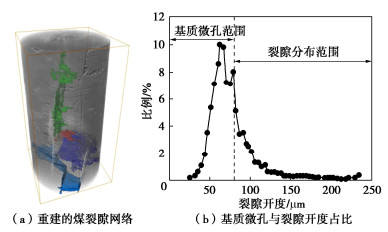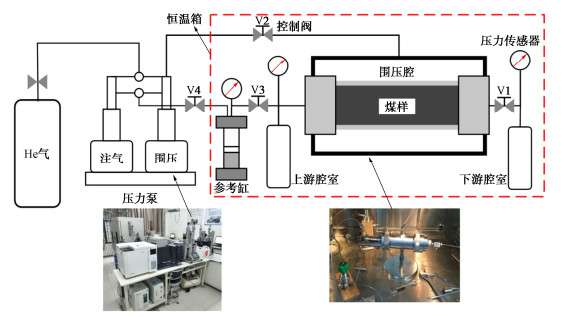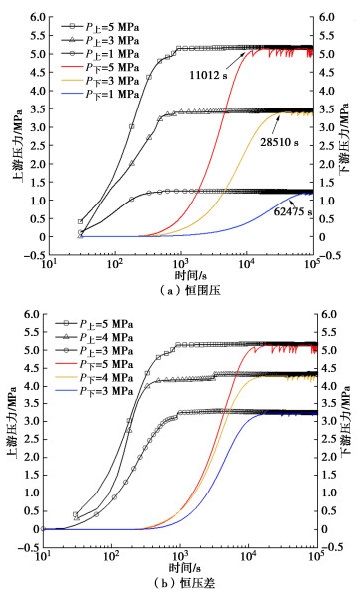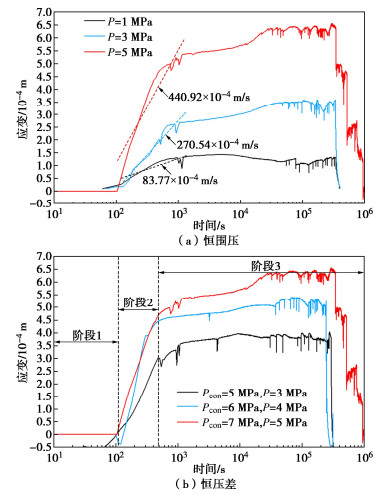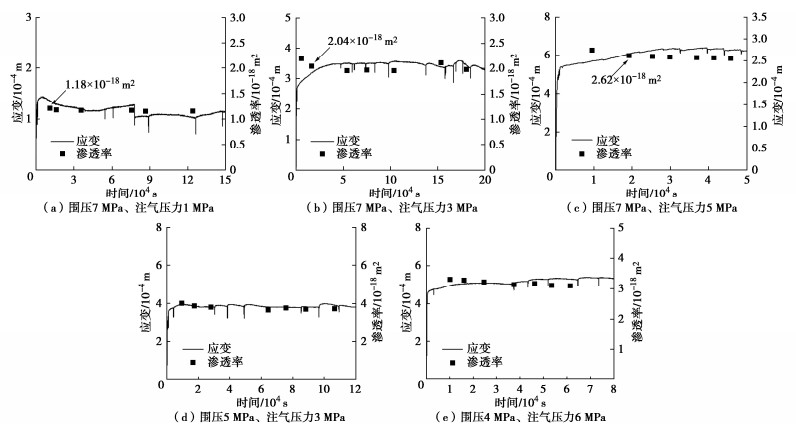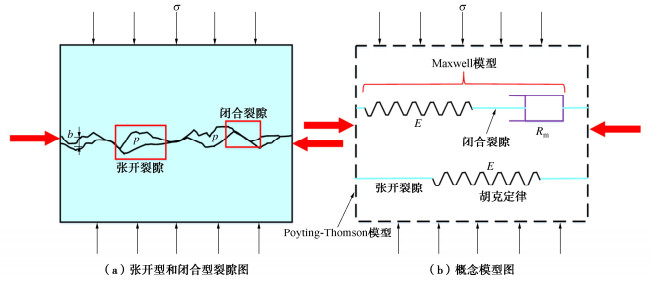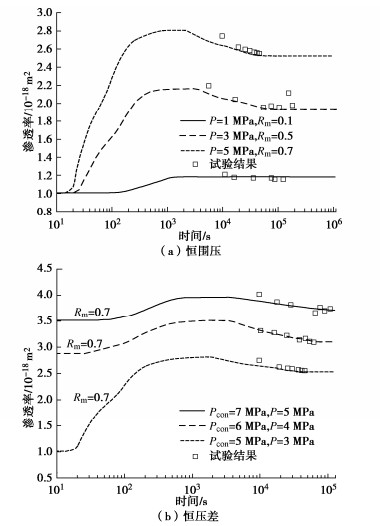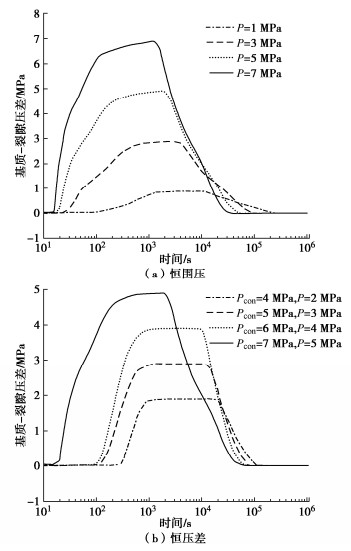Influences of softening behaviour of coal on evolution of its permeability by considering matrix-fracture interactions
-
摘要: 瞬态渗透率是提高煤层气产量的重要依据。为了得到基质-裂隙压力相互作用出现煤的软化行为对渗透率演化的影响。基于理论分析建立含模量软化系数的双重孔隙介质渗透率模型,并基于脉冲瞬态试验与COMSOL有限元数值模拟软件进行渗透率模型的验证。结果表明:根据曲线变化特征,将应变分为初始,快速增长和平衡阶段。在快速增长阶段,注气压力从1 MPa增大到3 MPa应变曲线的斜率分别为83.77,270.54,440.92 m/s。模量软化系数是应变的函数,其值也增大;其次,通过提出张开型和闭合型裂隙几何概念模型,得到含模量软化系数的双孔渗透率模型;最后,试验数据与改进的渗透率模型结果一致,证明模量软化系数主导了渗透率的动态演化。与试验方法相比,数值模拟方法能够监测煤基质的压力,基质与裂隙之间气体压力的变化揭示了煤渗透率演化机理。Abstract: The evolution of dynamic permeability is an important basis for improving the production of coal bed methane. In order to obtain the influences of the softening behavior of coal from matrix-fracture pressure interactions on the evolution of its permeability, a dual-pore permeability model with modulus reduction ratio from differential pressure is obtained through theoretical analysis and is validated based on the permeability transient method tests and the finite element numerical simulation software COMSOL. The experimental results show that the strain is divided into the initial, rapid growth and equilibrium phases based on the characteristics of the curve change. During the rapid growth phase, the slope of the strain curve increases from 1 to 3 MPa with slopes of 83.77, 270.54, 440.92 m/s respectively. The modulus-softening coefficient is a function of the strain and its value increases. Furthermore, a dual-pore permeability model with modulus-softening coefficient is obtained by proposing a conceptual model for open and closed fractures. The experimental data are consistent with the results of the improved permeability model, demonstrating that the modulus-softening coefficient dominates the dynamic evolution of the permeability. Finally, the numerical simulation method can be used to monitor the pressure in the coal matrix compared to the experimental method. Thus, the pressure difference between the matrix and the fracture reveals the mechanism of permeability evolution in coal samples.
-
0. 引言
随着中国交通行业的不断发展,中国桥梁建设水平得到大幅提升,对桥梁跨越能力的要求也不断增长,悬索桥作为所有桥型中跨越能力最大的桥型,越来越成为跨越大江、大河的主要解决方案。但是随着悬索桥跨度的不断增加,锚碇规模急剧扩大,造成锚碇建设成本过高。因此研究锚碇沉井基础的受力变形特性对于悬索桥的锚碇优化设计显得尤为重要。
Alampalli[1]在1994年研究了沉井在承受竖向和水平向荷载时的结构响应;李永盛[2]和李家平等[3]分别在1995年和2005年通过模型试验探讨了沉井基础的变形机制和破坏失稳形式;穆保岗等[4]在2017年通过模型试验研究了水平荷载长期作用下沉井变位的特性;Liu等[5]在2019年通过模型试验结合数值模拟分析研究了重力式锚碇的稳定性。
本文首先进行了在分级水平荷载下的沉井在砂箱中的模型试验,然后基于PLAXIS 3D软件建立了有限元模型,并分析了沉井的位移及沉井前侧和沉井底部的土压力,研究了水平荷载条件下沉井的受力变形规律。
1. 依托工程及模型试验
本文依托南京仙新路大桥北锚碇沉井工程,沉井长度为70 m,宽度为50 m,高度为49.5 m。该工程地基土以粉砂和中砂为主。
本试验采用的模型槽平面尺寸为4.0 m×2.0 m,高1.0 m。地基土采用中砂,其相对密度为2.68,最大孔隙比0.881,最小孔隙比0.463,不均匀系数3.89,曲率系数0.92。模型试验分层填筑地基土,控制每层填土的厚度为0.1 m,最终得到地基土的干密度为1.55 g/cm3,含水率0.63%,相对密实度为59.61%,内摩擦角为34.5°(快剪)。
沉井模型平面尺寸为0.7 m×0.5 m,高0.495 m,由厚度为22 mm的钢板焊接而成,试验过程将沉井看成刚体,不考虑沉井自身的变形,为模拟沉井与土体相互作用的界面,通过在沉井表面黏2~3 mm的砂粒实现[6],如图1所示。
模型试验中设计荷载为62kg,本文中水平荷载分级施加,每级荷载为设计荷载的~0.5倍,试验过程中每级荷载施加持续15 min直至土体破坏(土体破坏表现为沉井盖板处的位移急剧增大),沉井加载示意图如图2所示。
2. 有限元分析
本研究建立的有限元模型完全基于模型试验,土体及沉井的单元形状均为四面体十节点实体单元,数值模型的网格如图3所示。
砂土的本构模型采用土体硬化(HS)模型,土层参数[7]取值见表1。
表 1 土层参数Table 1. Soil parameters土层 γ /(kN·m-3)e Es /MPaErefoed /MPaEref50 /MPaErefur /MPac′ φ′ /(°)ψ /(°)m 砂土 15.6 0.723 10.2 10.2 10.2 30.6 0 34.5 0 0.5 注: γ 为砂土的重度;e 为砂土的孔隙比;Es 为砂土的压缩模量;Erefoed 为砂土的主固结加载切线刚度;Eref50 为砂土的标准三轴排水试验割线刚度;Erefur 为砂土的卸载重加载刚度;c′ 为砂土的有效黏聚力;φ′ 为砂土的有效摩擦角;ψ 为砂土的膨胀角;m 为砂土的刚度应力水平相关幂值。3. 试验结果与有限元结果对比
3.1 沉井顶部位移
在沉井盖板顶部设置3个位移测量点A、B、C。在位移测量点上放置位移靶标,采用TH-ISM-ST机器视觉测量仪对靶标位移进行测量,分辨率为0.01 mm,靶标布置如图4。
模型试验和数值模拟的位移对比如图5所示,由图易知,模型试验和数值模拟的靶标位移较为一致,本文中取水平位移随设计荷载增加而不断增加的线弹性阶段为水平承载力极限值[4],即安全系数取值为4。
3.2 沉井前侧壁土压力随施加荷载变化
在沉井前侧设置8个土压力盒,布置如图6所示,由于土压力盒对称分布,且沉井左右侧完全对称,因此取沉井左右两侧土压力盒平均值作为最终结果,结果如图7所示,其中模型试验中3号及3'号土压力盒数据较差,本文中已舍弃,余下的沉井前侧土压力盒数据和数值模拟结果较吻合。
3.3 沉井前侧壁土压力随施加荷载变化
在沉井底部设置12个土压力盒,布置如图8所示,同理,取沉井左右两侧土压力盒平均值作为最终结果,结果如图9所示,其中8号及8'号土压力盒数据较差,本文中已舍弃,余下的沉井底部土压力盒数据和数值模拟结果对比,发现当施加荷载/设计荷载的值小于等于4时较一致,当其值大于4之后,二者的结果相差较大。
4. 结论
本文在已有的研究基础上,通过开展模型试验和数值模拟计算,得到水平荷载下沉井的受力变位特性,主要得出以下结论:
(1)对锚碇沉井基础在砂土中的受力变位特性进行了试验研究和有限元分析,结果显示,水平荷载下锚碇沉井基础在砂土中的破坏模式为倾覆破坏,且安全系数远大于2,说明现阶段规范[8]中锚碇设计较为保守,有进一步的优化空间。
(2)通过PLAXIS 3D软件建立了锚碇沉井基础的有限元模型,采用应变硬化的本构模型,结果表明模型试验的结果和有限元模型计算的结果较为一致,说明数值建模过程中的土体本构模型及参数取值可靠,表明PLAXIS 3D软件能够较好的模拟锚碇沉井在砂土中的受力变形行为。
上述模型试验和有限元分析,只是针对水平荷载条件下锚碇沉井基础在砂土中的受力特性开展的研究,只考虑了单层干砂的地基土层,尚需更近一步探索。
-
表 1 不同边界条件下的试验方案
Table 1 Experimental schemes of different boundary conditions
方案 围压/MPa 注气压力/MPa 边界条件 1 7 1 恒围压 2 7 3 恒围压 3 7 5 恒围压 4 5 3 恒压差 5 6 4 恒压差 6 7 5 恒压差 表 2 模拟采用的物理力学参数
Table 2 Physical and mechanical parameters in simulations
参数 取值 煤杨氏模量Et/ GPa 3.766 裂隙杨氏模量Ef/GPa 1.461 基质杨氏模量Em/ GPa 6.366 泊松比ν 0.339 气体黏度μ/(pa⋅s) 1.84×10-5 形状因子f/m-2 1 初始渗透率k0/m2 1.80×10-18 煤的密度ρc/(kg·m-3) 1250 初始孔隙压力p0/MPa 0.1 裂隙的初始孔隙率ϕf0/% 2 基质的初始孔隙率ϕm0/% 2.6 -
[1] WANG C G, ZHANG J D, CHEN J G, et al. Understanding competing effect between sorption swelling and mechanical compression on coal matrix deformation and its permeability[J]. International Journal of Rock Mechanics and Mining Sciences, 2021, 138(6): 104639–104651.
[2] 陈月霞, 许江, 褚廷湘, 等. 相似煤储层瓦斯压力计算模型及其空间分布特征[J]. 中国矿业大学学报, 2021, 50(3): 606–612. doi: 10.13247/j.cnki.jcumt.001292 CHEN Yue-xia, XU Jiang, CHU Ting-xiang, et al. Calculation model of gas pressure in similar coal reservoir and its spatial distribution characteristics[J]. Journal of China University of Mining & Technology, 2021, 50(3): 606–612. (in Chinese) doi: 10.13247/j.cnki.jcumt.001292
[3] 秘昭旭, 王福刚, 石娜, 等. 多期次应力变化对砂岩渗透率和孔隙结构影响的试验研究[J]. 岩土工程学报, 2018, 40(5): 864-871. http://manu31.magtech.com.cn/Jwk_ytgcxb/CN/abstract/abstract17356.shtml MI Zhao-xu, WANG Fu-gang, SHI Na, et al. Experimental study on effect of multi-stage stress variations on permeability and pore structure of sandstone[J]. Chinese Journal of Geotechnical Engineering, 2018, 40(5): 864–871. (in Chinese) http://manu31.magtech.com.cn/Jwk_ytgcxb/CN/abstract/abstract17356.shtml
[4] LIU J S, CHEN Z W, ELSWORTH D, et al. Linking gas-sorption induced changes in coal permeability to directional strains through a modulus reduction ratio[J]. International Journal of Coal Geology, 2010, 83(1): 21–30. doi: 10.1016/j.coal.2010.04.006
[5] 肖智勇, 王长盛, 王刚, 等. 基质-裂隙相互作用对渗透率演化的影响: 考虑基质变形和应力修正[J]. 岩土工程学报, 2021, 43(12): 2209–2219. http://manu31.magtech.com.cn/Jwk_ytgcxb/CN/abstract/abstract18907.shtml XIAO Zhi-yong, WANG Chang-sheng, WANG Gang, et al. Influences of matrix-fracture interaction on permeability evolution: considering matrix deformation and stress correction[J]. Chinese Journal of Geotechnical Engineering, 2021, 43(12): 2209–2219. (in Chinese) http://manu31.magtech.com.cn/Jwk_ytgcxb/CN/abstract/abstract18907.shtml
[6] ANGGARA F, SASAKI K, SUGAI Y. The correlation between coal swelling and permeability during CO2 sequestration: a case study using Kushiro low rank coals[J]. International Journal of Coal Geology, 2016, 166(9): 62–70.
[7] BOTTOMLEY W, FURNISS J P, RAZA S S, et al. Characterising the dependence of coal permeability to methane adsorption, pore pressure and stress: laboratory testing of Walloon coals from the surat basin[C]// SPE/IATMA Asia Pacific Oil and Gas Conference. Jakarta, 2017: 18675–18687.
[8] BRACE W F, WALSH J B, FRANGOS W T. Permeability of granite under high pressure[J]. Journal of Geophysical Research Atmospheres, 1968, 73(6): 2225–2236. doi: 10.1029/JB073i006p02225
[9] KUMAR H, ELSWORTH D, LIU J S, et al. Optimizing enhanced coalbed methane recovery for unhindered production and CO2 injectivity[J]. International Journal of Greenhouse Gas Control, 2012, 11(11): 86–97.
[10] KUMAR H, ELSWORTH D, LIU J S, et al. Permeability evolution of propped artificial fractures in coal on injection of CO2[J]. Journal of Petroleum Science and Engineering, 2015, 133(9): 695–704.
[11] FENG R M, HARPALANI S, PANDEY R. Evaluation of various pulse-decay laboratory permeability measurement techniques for highly stressed coals[J]. Rock Mechanics and Rock Engineering, 2017, 50(2): 297–308. doi: 10.1007/s00603-016-1109-7
[12] VIETE D R, RANJITH P G. The effect of CO2 on the geomechanical and permeability behaviour of brown coal: implications for coal seam CO2 sequestration[J]. International Journal of Coal Geology, 2006, 66(3): 204–216. doi: 10.1016/j.coal.2005.09.002
[13] LARSEN J W. The effects of dissolved CO2 on coal structure and properties[J]. International Journal of Coal Geology, 2004, 57(1): 63–70. doi: 10.1016/j.coal.2003.08.001
[14] SALARI M R, SAEB S, WILLAM K J, et al. A coupled elastoplastic damage model for geomaterials[J]. Computer Methods in Applied Mechanics and Engineering, 2004, 193(27/28/29): 2625–2643.
[15] HU S B, WANG E Y, KONG X G. Damage and deformation control equation for gas-bearing coal and its numerical calculation method[J]. Journal of Natural Gas Science and Engineering, 2015, 25(7): 166–179.
[16] WANG E Y, KONG X G, HU S B, et al. Multi-scale fractured coal gas–solid coupling model and its applications in engineering projects[J]. Transport in Porous Media, 2018, 121(3): 703–724. doi: 10.1007/s11242-017-0981-2
[17] CHEN D, PAN Z J, SHI J Q, et al. A novel approach for modelling coal permeability during transition from elastic to post-failure state using a modified logistic growth function[J]. International Journal of Coal Geology, 2016, 163(6): 132–139.
[18] CUI X J, BUSTIN R M. Volumetric strain associated with methane desorption and its impact on coalbed gas production from deep coal seams[J]. AAPG Bulletin, 2005, 89(9): 1181–1202. doi: 10.1306/05110504114
[19] ZHANG X M, ZHANG D M, LEO C J, et al. Damage evolution and post-peak gas permeability of raw coal under loading and unloading conditions[J]. Transport in Porous Media, 2017, 117(3): 465–480. doi: 10.1007/s11242-017-0842-z
[20] ZHU W C, WEI C H, LI S, et al. Numerical modeling on destress blasting in coal seam for enhancing gas drainage[J]. International Journal of Rock Mechanics and Mining Sciences, 2013, 59(4): 179–190.
[21] ZHENG C S, KIZIL M, CHEN Z W, et al. Effects of coal damage on permeability and gas drainage performance[J]. International Journal of Mining Science and Technology, 2017, 27(5): 783–786. doi: 10.1016/j.ijmst.2017.07.009
[22] WANG L S, CHEN Z W, WANG C G, et al. Reassessment of coal permeability evolution using steady-state flow methods: the role of flow regime transition[J]. International Journal of Coal Geology, 2019, 211(7): 103210–103223.
[23] WANG C G, ZANG Y X, WANG L S, et al. Interaction of cleat-matrix on coal permeability from experimental observations and numerical analysis[J]. Geofluids, 2019, 19(11): 1–15.
[24] 刘江峰, 倪宏阳, 浦海, 等. 多孔介质气体渗透率测试理论、方法、装置及应用[J]. 岩石力学与工程学报, 2021, 40(1): 137–146. https://www.cnki.com.cn/Article/CJFDTOTAL-YSLX202101013.htm LIU Jiang-feng, NI Hong-yang, PU Hai, et al. Test theory, method and device of gas permeability of porous media and the application[J]. Chinese Journal of Rock Mechanics and Engineering, 2021, 40(1): 137–146. (in Chinese) https://www.cnki.com.cn/Article/CJFDTOTAL-YSLX202101013.htm
[25] CHEN Z W, PAN Z J, LIU J S, et al. Effect of the effective stress coefficient and sorption-induced strain on the evolution of coal permeability: experimental observations[J]. International Journal of Greenhouse Gas Control, 2011, 5(5): 1284–1293.
[26] XIE H C, NI G H, LI S, et al. The influence of surfactant on pore fractal characteristics of composite acidized coal[J]. Fuel, 2019, 253(10): 741–753.
[27] JAEGER J C, COOK N G W, ZIMMERMAN R W. Fundamentals of Rock Mechanics[M]. Oxford: Wiley-Blackwell Publishing, 2007: 312–465.
[28] LIU J S, WANG J G, CHEN Z W, et al. Impact of transition from local swelling to macro swelling on the evolution of coal permeability[J]. International Journal of Coal Geology, 2011, 88(1): 31–40.
[29] ZHANG H B, LIU J S, ELSWORTH D. How sorption-induced matrix deformation affects gas flow in coal seams: a new FE model[J]. International Journal of Rock Mechanics and Mining Sciences, 2008, 45(8): 1226–1236.
[30] RANJBAR E, HASSANZADEH H. Matrix-fracture transfer shape factor for modeling flow of a compressible fluid in dual-porosity media[J]. Advances in Water Resources, 2011, 34(5): 627–639.




 下载:
下载:








